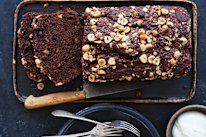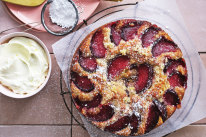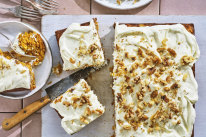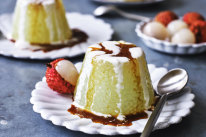Gluten-free pineapple and polenta cake
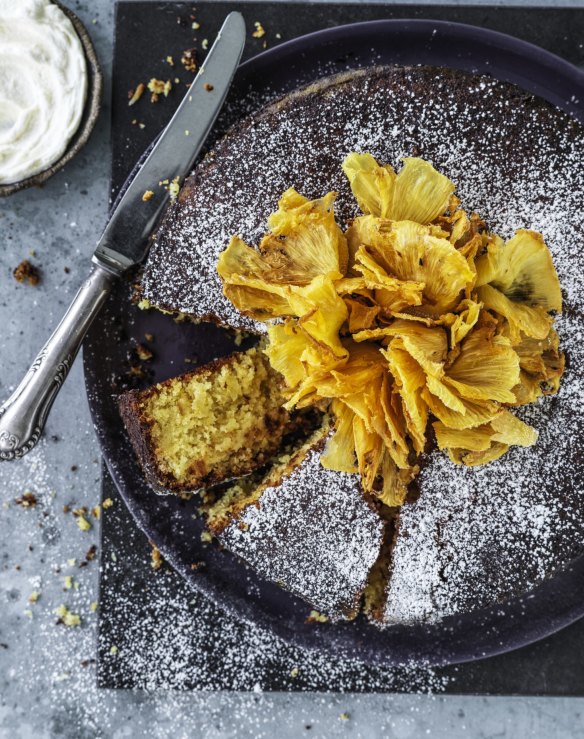
This gluten-free cake owes its pleasingly gritty texture to nuts, polenta and coconut, and its gently acidic tang to fresh pineapple. Using tinned pineapple will halve the preparation time as you won't need to slice or cook the fruit, but you won't get all the wonderfully complex, juicy fruit flavours that a fresh pineapple delivers.
Ingredients
1 large, ripe pineapple (about 900g)
250g almond meal
125g fine polenta
50g desiccated coconut
1½ tsp baking powder
¼ tsp finely crushed cardamom seeds (optional)
½ tsp salt
250g unsalted butter, cubed (at room temperature)
250g castor sugar
zest of 1 orange (or 2 limes)
4 large eggs, lightly beaten
icing sugar, for dusting
Greek yoghurt or whipped cream, to serve
Method
1. Prepare the pineapple: cut away the ends and tough skin, and remove the "eyes". Cut the pineapple in half lengthwise, then cut one of the halves into roughly 4-5cm pieces, discarding the core. You need 400g of pineapple pieces at this point – if you don't have enough, cut some from the other pineapple half, keeping its semi-circular shape, as it will be used to make decorative flowers later.
2. Place the pineapple pieces into a food processor and process until finely crushed, then transfer to a small saucepan and bring to a boil. Simmer for one minute, then strain the pineapple through a fine metal sieve placed over a bowl. Press gently on the pulp to release as much of the juice as possible – you should have about 200g of flesh and 200ml of juice. Scrape the flesh into a small bowl and leave the collected juice in the bowl for the time being. (If using tinned pineapple, you will need a 450g tin of the fruit in its own juice, crushed in a food processor and strained without cooking.)
3. Preheat the oven to 190C (170C fan-forced) and line the base and sides of a 22cm round springform tin with baking paper.
4. Place the almond meal, polenta, coconut, baking powder, cardamom (if using) and salt in a bowl and whisk to combine. Set aside for now.
5. Combine butter, sugar and orange (or lime) zest in the bowl of a cake mixer and beat with the paddle attachment on medium-high speed until creamy. Slowly add the eggs, scraping down the sides of the bowl a few times – the mixture might look a bit curdled, but don't worry, this will not affect the end result. Remove the bowl from the machine and fold in the dry ingredients and pineapple flesh. Scrape the batter into the prepared tin and level the top with a spatula. Bake for 55 to 60 minutes or until a skewer inserted into the centre of the cake comes out clean.
6. While the cake is in the oven, make the syrup: pour the pineapple juice (fresh or tinned) into a saucepan and reduce over high heat until there's about 150ml left. Set it aside to reach room temperature.
7. When the cake comes out of the oven, spoon the syrup all over the top of the cake. Allow to cool completely before releasing the cake from the tin and transferring to a serving plate.
8. To make the dried pineapple flowers, preheat the oven to 150C (130C fan-forced). Slice the remaining pineapple into wafer-thin semicircles and place (without overlapping) on a baking tray lined with baking paper. Bake for about 20 minutes, or until the slices are semi-dried and begin to take on some colour at the edges – they should still be pliable. Remove from the oven and allow to cool.
9. When ready to serve, dust the top of the cake liberally with icing sugar. Scrunch up the dried pineapple slices and gather at the base to form a large "flower". Place in the centre of the cake. Serve with Greek yoghurt or whipped cream.
Appears in these collections
The best recipes from Australia's leading chefs straight to your inbox.
Sign upMore:
From our partners
Similar Recipes
More by Helen Goh
Original URL: https://www.theage.com.au/goodfood/recipes/glutenfree-pineapple-and-polenta-cake-20190913-h1hztv.html

